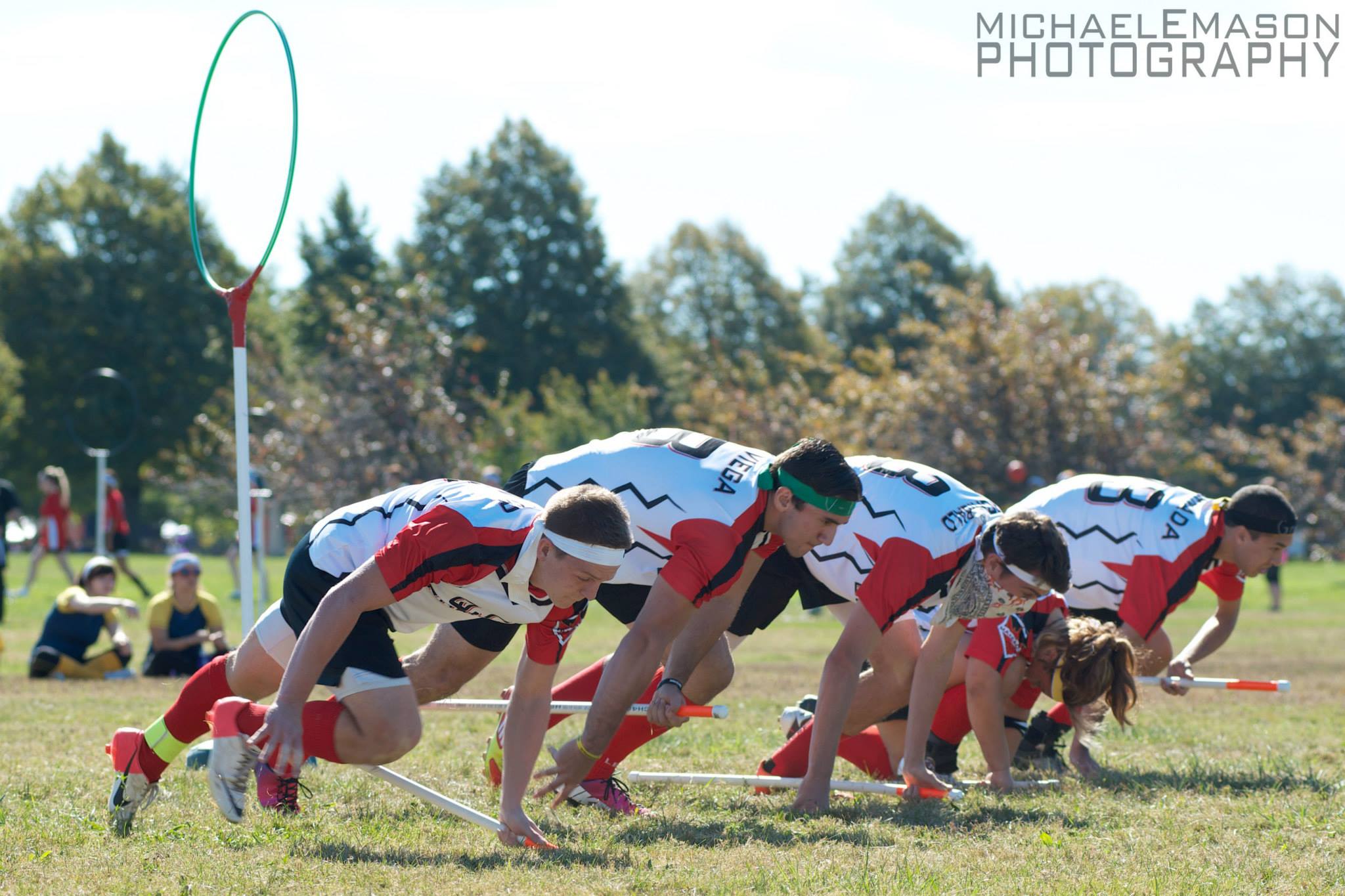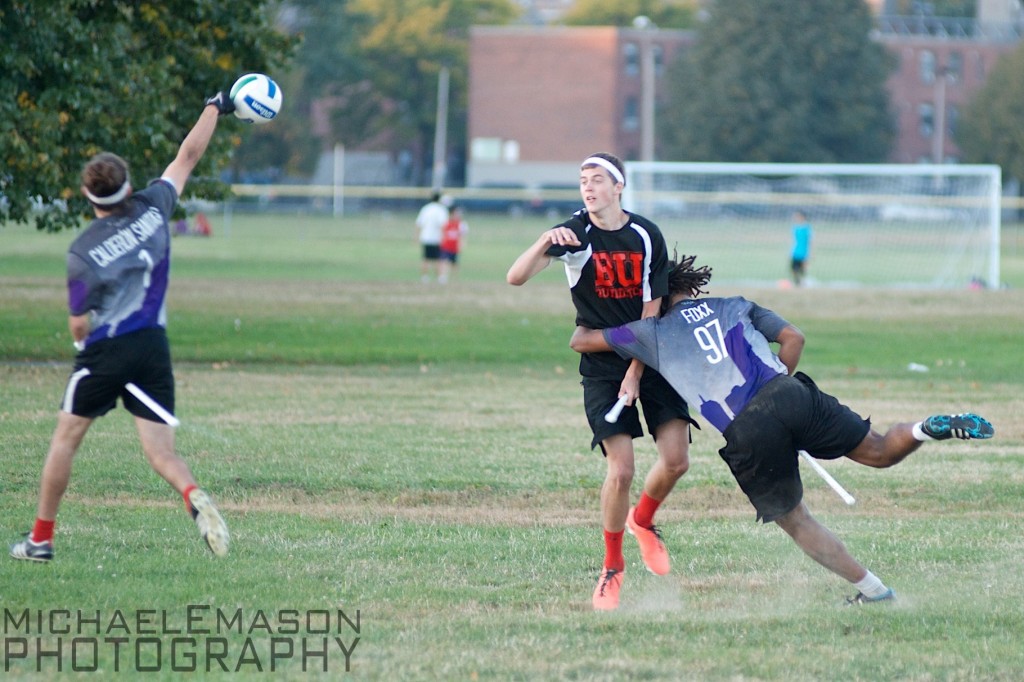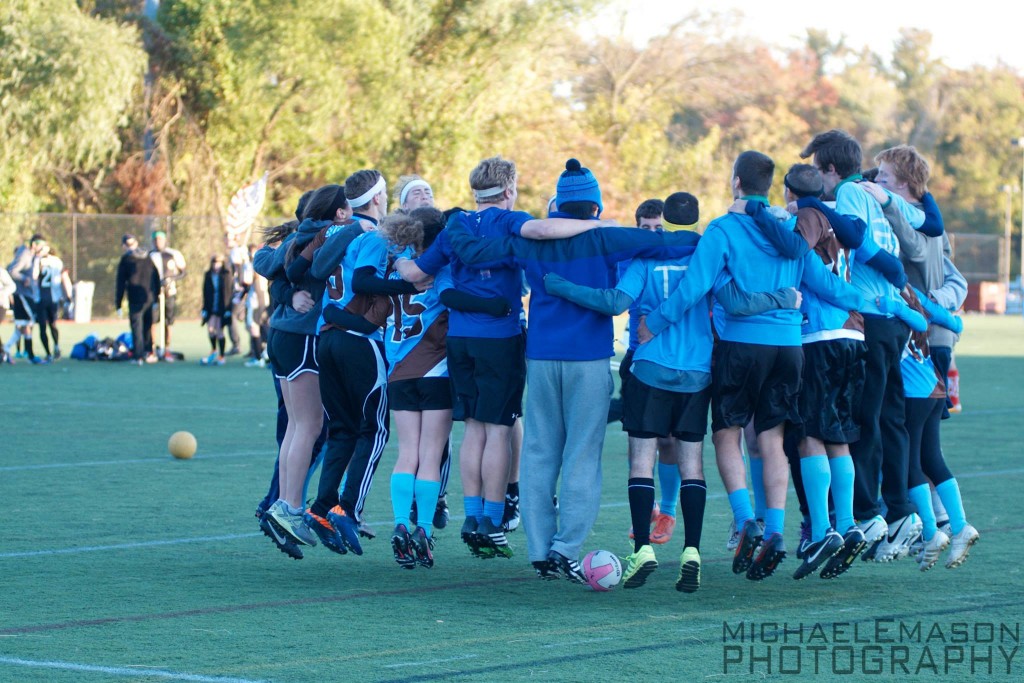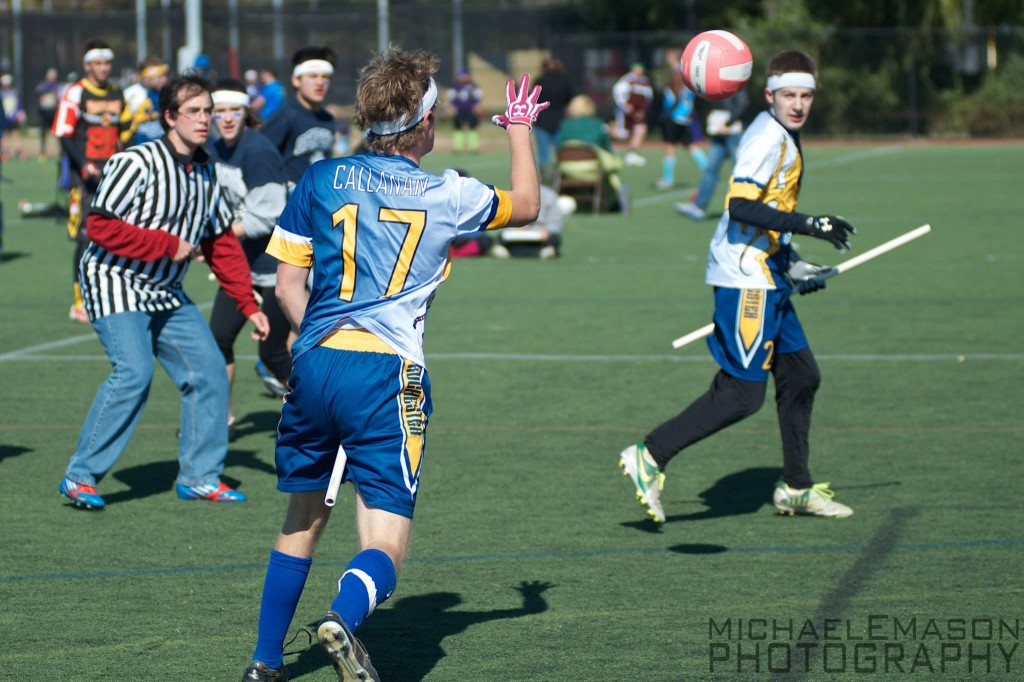- Rule, Britannia, no more?
- Unpopular Opinions: US Quadball Cup 2023
- Proven Contenders: University of Virginia
- Proven Contenders: Rutgers University
- Proven Contenders: University of Michigan
- Proven Contenders: Creighton University
- Different Perspectives: A Look Inside USA Ultimate
- Antwerp QC, Much of Belgian Core, Leaves Competitive Quidditch
2013 Northeast Regional Preview
- Updated: November 12, 2013

After years of criticism, the rest of the country finally got the last laugh when, with Middlebury finally out of the picture, no Northeast team made it to the quarterfinals of World Cup VI. This season, it has been up to the region as a whole to rewrite its perception, and with the strong finishes of Emerson College and Tufts at Turtle Cup, the process seems to be well on its way.
But while Emerson and Tufts succeeded at Turtle Cup, Hofstra and Rochester fell flat, bringing up the oft-asked question of whether the entire region really just boils down to the city of Boston. Now, not only must the teams of the Snowbelt and Big Apple Conferences prove to the country that the Northeast is just as competitive as any other region, but they also must prove to the Boston Four that they deserve to be on the same pitch.
As 25 teams descend on the snowy city of Rochester, N.Y. to fight it out for 12 World Cup bids, the stakes are high and the whole country will be watching. The Northeast’s sub-regions have made comparing teams difficult, but all will be answered this weekend. Below, we look at the favorites for the title, the other teams that could contend, the remaining teams we expect to see leaving Rochester with World Cup tickets, and the outsiders that could steal one before things are done.
The Favorites
No. 6 Boston University
Last season’s champions are once again this season’s favorites. While they have only managed to split a season series with Emerson, those two losses both came on a day where depth issues forced Max Havlin to chase instead of beat. And it has been Havlin, along with beating partner Katrina Bossotti, that have been the biggest step up in the Terriers’ game this season. Their beating is aggressive in a way otherwise unseen in the region, and because they have yet to leave Boston this season, many teams who haven’t faced it won’t be able to adjust in time. Combine such a strong beating game with Brendan Stack, whose physicality and deadly midrange shot allow him to maintain the title of best keeper in the Northeast, and Michael Powell, an All-Northeast caliber player who gets no attention at chaser, and this team has enough talent to blow out almost anyone. And in what will likely be an even finals match against Emerson, I like the veteran hands of seeker Tom Ford to come through with the catch.

While David Fox and Pablo Calderon are well known entities on Emerson, Michael Powell is just as valuable to BU. Credit: Michael E. Mason/IQA Staff
No. 7 Emerson College
Emerson has done just about everything it can to avoid repeating the mistakes of a disappointing 2012-2013 campaign. They are playing highly competitive games in Boston almost every weekend, and even traveled to Maryland to play games against elite out-of-region competition. They are also a well-structured team with systems on both offense and defense, where they run a 1-2-2-1 zone. The new defense has done its job so far this season, and despite playing one of the most difficult schedule in the country, the Lions have yet to allow more than 80 quaffle points in a game. This team has playmakers everywhere on the depth chart, with Aaron Wohl at beater and David Fox and Tyler Trudeau at keeper as close to “stars” as this team gets. But in any tournament, any of the squad’s players can take over, as Jake Hines proved at Turtle Cup, and with a bevy of freshmen, including both of the team’s main seekers, still moving towards their potential, we’ll have to wait and see who ends up leading this team to a likely finals appearance in Rochester.
The Contenders
No. 15 Tufts University
Always the bridesmaid but never the bride, Tufts remains the best program in quidditch to have never won a tournament at any level, most recently coming up short against crosstown rival Emerson in the finals of Turtle Cup. And while this year’s team appears capable of eliminating that stigma, I’m not sure this tournament will be the place they do it. With beater Michael Sanders on the pitch, Tufts can compete in the bludger game with any team in the region, Hannah DeBaets, Emily Hickmott and Madeleine Lebovic comprise the strongest female chaser line in the Northeast, and their young male quaffle players – none of the chasers on the team’s regionals roster are upperclassmen – are more physical than anything we’ve seen from the team in the past. But with chaser/seeker BJ Mestnik out for the weekend, the team has lost its one and only closer, and likely its shot at the title, as early season results show a team that can’t close out a win against a good team without him on the pitch. Still, this is a team with wins over two top 10 teams already on its resume, and anything can happen in a single elimination bracket.

Tufts may be as close at its ever been to a tournament title. But is this the weekend? Credit: Michael E. Mason/IQA Staff
No. 16 Boston Massacre
So far this fall, the Massacre have fallen short of the lofty expectations placed on them. They are 1-7 against the other three top Boston teams – 0-3 in official games – and their depth issues have caused problems at every turn, leaving them weak anytime they had to deal with an injury or a player who has to miss a match. Their bludger game also remains average at best, and no performance we have seen from their beaters so far is anywhere close to regionals-winning level. But things are looking up for this weekend. One can only assume they will have nearly a full roster this weekend, and with Matt Lowe allegedly replacing the injured Griffin Conlogue, the team will barely miss a beat there. Meanwhile, their beaters have now had plenty of time to mesh, while Kara Levis has had a lot of time to rehab the injury that could be contributing to hampering her play. If everything comes together, they still probably don’t have the seeking ability or depth to win this tournament, but with the talent they possess in the quaffle game, they can definitely make waves.
Hofstra University
Right now, this team is pretty easy to breakdown. Alex Leitch possesses the ability to take over games by himself, and fellow beater Theresa Buchta has become a skilled compliment to what Leitch can do. Jaime Colon returned for Turtle Cup, and quickly became the focal point of the offense, while their younger players continue to develop. A beater game at this team’s level is going to be able to keep most games close, which truly makes Hofstra the second tier team that none of the regional giants want to see. That being said, the Flying Dutchmen have yet to prove they have much of a seeking game – they are just 2-2 in SWIM situations – and Colon playing heroball is unlikely to result in many points against the top teams. Still, if they can squeak out a pool victory in the Group of Death, they will be in position for at least an easy qualification, if not more.

Sharp new uniforms were about all Rochester had going for it at Turtle Cup due to major roster issues. Credit: Michael E. Mason/IQA Staff
University of Rochester
With a roster depth matched only by the size of its injured reserve, Rochester boasts a speedy transitional offense and a solid passing game which, combined with a strong beater corps, has led to a high-powered offense that has easily dominated overmatched Snowbelt Conference opposition. At Turtle Cup, lacking much of their ideal starting lineup, the Thestrals appeared too reliant on Devin Sandon, whose current injury woes may make playing difficult for him this weekend, while Harry Clarke continued to fall short of the high-level beater he was in the past. We don’t want to count them out until we’ve seen their best lineup facing off with elite competition, but facing the toughest pool in the tournament, they are definitely the top team with the most to worry about come Saturday.
The Qualifiers
Rochester Institute of Technology
Eschewing speed to some degree in favor of power, RIT has a tremendously physical defense which has allowed on average 30.9 quaffle points per game and held World Cup qualifier McGill University to just 20 points. However, RIT’s offense struggles at time, with an average output of 57.3 quaffle points per game. Consequently, seeking becomes a fairly important area for RIT, which has maintained a 45.5 percent snitch pull percentage, and a 50 percent mark in SWIM situations. RIT favors a relatively slow pace of play and a grind it out mentality on both sides of the ball, where the team utilizes its solid athleticism to advance a drive-heavy offense epitomized by chaser Andrew Hollenbach. They will perhaps be the team that benefits most from the Snowbelt’s icy homefield advantage, as a climate that affects passing and beating will benefit the biggest, strongest teams that can pound their way to the hoops. The risk of a snitch pull upset in a low-scoring game is what leaves this side just outside of the contenders, but qualifying should be nothing more than an afterthought, especially in one of the tournament’s weakest pools.
New York University
Early on in the season, consistency seemed to plague this team, as their performance at Nittany Cup shows. However, NYU appears to have found their stride after sweeping the NYC Pre-Regional Scrimmages. NYU’s chaser game has developed a crisp offensive game. The chasers have good pitch awareness and have demonstrated the ability to stretch opponent’s defenses with precise passing. Zach Gindes’ arm has been a huge asset to NYU; his long shots are not only accurate but are thrown with pace as well, making it difficult for keepers to react in time. NYU’s chasers rarely get physical with their opponents, relying heavily on their beaters to make stops and force turnovers to both anchor the defense and create offense, as they rely heavily on the fast breaks created by such turnovers to score points. Luckily, they have some strong beaters, with Kyle Jeon continuing to impress after his breakout summer and Dylan Meechan proving capable enough as his backup to even allow Jeon to chase at times. The team also struggles in the quaffle game with the snitch on the pitch due to their reliance on beaters, thougt seeker Austin Sweeney is capable of ending games quickly as a sizable seeker with an impressive wingspan. Still, physical teams that can hold bludger control will prove to be this team’s biggest challenge. That said, I don’t think there are enough of those to keep this team out of the World Cup.
Macaulay Honors College
Macaulay has benefited so far this season from a strong recruiting class, as made evident at the Fresh and Fly Expo early in the season. Their problem this year has been getting consistent play out of their veterans. Max Rief, Andonio Mourdoukoutas and Shenuque Tissera have all had quiet seasons so far, making the rookies even more important. Luckily, the younger players have stepped up and quickly learned the game. The team’s offensive efficiency is much improved, an area that Macaulay struggled with last season. The team runs a fast-paced quaffle offense, with an aggressive beating attack, but have struggled to truly perfect that style, often giving their opponents easy fast break opportunities against bludgerless defenses in transitions. Macaulay’s beater game has developed over the year, but often times their beaters can be found getting too distracted by opposing beaters, leaving their defense vulnerable. Macaulay still has an elite seeking attack, led by Andrew Zagelbaum, making allowing this team to stay in snitch range a dangerous prospect. It’s also what will make them unlikely to succumb to upset, leaving them all but a lock for qualification.
Harvard University
Last year’s Regionals were a massive disappointment for Harvard, a program that had been consistently competitive at all levels up until that point. After defeating Tufts and making the finals of an early season MQC tournament, they brought a tiny roster to Regionals and depth issues and some bad breaks kept them on the outside looking in on World Cup, with many worried that the lack of a World Cup trip could hamper the program far into the future. Instead, captain Hank Smith has rallied the troops, recruiting a strong new group of players capable of making up for last season’s disappointments. Chaser Jon Jackson is capable of playing heroball against lesser teams with his large frame and speed, but has quickly gained enough understanding of the game to be a distributor as well. And he has a talented target for his passes in Carli Haggerty, who is already showing the potential to be one of the region’s best female chasers with her movement, agility and catching. Mix in Smith’s chasing and seeking and the return of CJ Curtis, who was a huge boon for the team before other commitments forced him away from the team last fall, and there is more talent in this small squad than in many full 21-man rosters in the region. And, despite being a Pot Five team, they have a friendly pool that they could easily finish second in.
New York Badassilisks
The Badassilisks have undergone a massive makeover this season. The squad has benefited both from recruiting new players into the sport and from college graduates landing in the city looking to play quidditch. In their most recent games, they were outplayed by Macaulay and NYU, losing 120-20 and 140-20, respectively, but were also without multiple key pieces, including coach Clay Dockery, whose knowledge of the game and leadership often give his team a leg up. The Badassilisk’s newer players are still developing their understanding of the game, with Jerry Astro potentially the best of the bunch as a potent point defender rarely see in the Northeast, but the veterans have come in and made a significant impact. Josh Stone and Nick Tobey have partnered up once again after leading SUNY Geneseo for much of their college careers, and are two of the most under-appreciated chasers in the region. While Tobey won’t be in attendance, Stone will play major minutes and give the offensive life. The Badassilisks try and play a physical game, but don’t have the depth to sustain a style. Their beaters are also playing more aggressively, but still lack the ability and understanding to completely succeed at it. Matthew Zeltzer has brought life to the Badassilisks seeking game, and has shown the ability to make clutch grabs throughout his playing career, including a 4-0 SWIM record so far this season and a win over NYU. Stone was able to lead Geneseo to a World Cup spot last year without too many pieces around him, and I believe this team has enough ability to help him get there again. The draw doesn’t hurt either: In pool play the Badassilisks get two very beatable SNEQC opponents and a chance to pull an upset against either Macaulay or RIT that would put them in complete control of their destiny.
Rensselaer Polytechnic Institute
With a speedy offense, solid physicality on defense, and a number of players capable of making shots from deep, RPI has boasted a very productive offense this year. They’ve used this ability to make short work of all but the best of the Snowbelt, even avenging an early season snitch grab loss to Syracuse with a 110*-20 win at the end of October. I expect this team to have its way with any lower tier team it comes across, which may be enough to get it to Myrtle Beach. If there are any red flags, it’s in the seeking game. Their seekers have barely been tested in SWIM situations, and their loss to Syracuse included not one but two snitch grabs for the Orangemen. Overall, the team is just 50 percent overall on snitch pulls and 33 percent in SWIM situations. However, a tough draw against three Massachusetts teams could make life difficult for this squad, and many of the team’s in contention for World Cup spots are much more experienced at the elite level of play than they are.
The Outsiders
UMass Amherst
It’s really difficult to leave this team just on the outside looking in. They return most of the roster that last year qualified for the World Cup and in Kissimmee played Purdue University to an even game and hung around with Arizona State. They have an ever-improving beating game led by Robert Vortherms, and a physical quaffle game buoyed by Thomas Walsh, though they have struggled to recover from the graduation of Graham Walsh and Marcelo Portugal. They are also experienced and were active in the summer quidditch scene, getting even more individual practice in. But the results they have produced show a different story. This is a team that dropped an excusable game in overtime to the Badassilisks, but lost a completely inexcusable one to Clark University at the MQC/SNEQC Invitational. The biggest takeaway from both of those results is a lack of a seeker game, which could be a killer for a team that took the long road to qualification last year. If they can’t beat RPI and grab the third spot in their pool, things could get rough.
SUNY Geneseo
Despite the age of the program, Geneseo’s team this year is quite young. But the squad has improved dramatically through the season so far, both in an absolute and comparative sense. The team’s offense is built on speedy chasers and quick passing, and Geneseo lacks their trademark physicality on both sides of the ball this year, which may catch many of those familiar with Geneseo off guard. Their results have been mixed so far this season, but they have generally dominated lesser teams, which was what they were able to use to make a World Cup qualifying run last season. However, they are in arguably the tournament’s deepest pool, with only one team they will likely be able to roll. Their 11 am game against Syracuse, a team they have split a season series with so far, could very well serve as something of an elimination game, with the winner getting a huge step up on Sunday.
Alfred University
One of the newer teams in upstate New York, victories over Syracuse and Geneseo has launched Alfred into the conversation. With 46.7 average quaffle points per game, and 51.1 points on average allowed per game, neither Alfred’s offense or defense stands out too much. What does stand out, however, is that they’ve caught the snitch 4 of the 5 times in SWIM situations. Could they qualify? The results say they definitely have the ability. But without more experience, I’m hesitant to put them above other contenders.
Stony Brook University
Stony Brook has gotten off to a slow start this season, most recently going 1-4 at the Poison Apple Invitational. They have yet to have Konstantinos Plakas at an official tournament, and their offense has clearly suffered. Stony Brook runs a conservative beater game, electing to keep a bludger by their hoops at all times. Their quaffle game doesn’t have very potent passing, so they rely heavily on their ability to drive individually, block bludgers, and collapse a defense. Their beating game runs through Ryan Sebade, with help from Sarah Moy, but they lack the depth to give them productive breaks. Stony Brook also struggles to regain bludger control because of their conservative style. Nick Beacher is often taken away from chasing to assist the beaters in regaining control. The seekers on Stony Brook have also struggled. This team has hung close with almost every New York City team, but have yet to prove capable of closing the deal. Such an issue could leave them falling short of a bid.
Syracuse University
With 16 conference games played as well as some non-conference games, Syracuse has had more games than most teams in the NE, which should hopefully lead to solid cohesion for their team. At the same time, their roster has varied greatly from match to match. Syracuse boasts a speedy transitional offense and a respectable beater corps which is often able to give the chasers excellent transitional opportunities. But they don’t have any results to show they’ve improved much from the team that came up just short of qualifying last season, and most of their best wins came early in the season, while more recent results haven’t been as impressive. That, mixed with the transient roster, makes them a huge question mark overall.
| Finish | Pool 1 | Pool 2 | Pool 3 | Pool 4 | Pool5 |
|---|---|---|---|---|---|
| 1st | Boston University | RIT | Tufts | Emerson | Massacre |
| 2nd | NYU | Macaulay | Harvard | SUNY Geneseo | Rochester |
| 3rd | Alfred | Badassilisks | RPI | Stony Brook | Hofstra |
| 4th | Brandeis | Clark | UMass | Syracuse | New Haven |
| 5th | Ithaca | URI | Skidmore | Grove City | India Point |
Devin Sandon and Shenuque Tissera provided reporting to this article.

One Comment